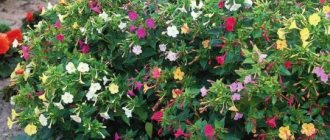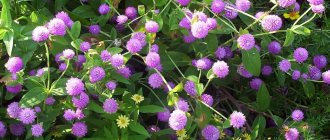The perennial known as Eremurus or foxtail loves quite specific climate conditions. The capriciousness of our weather, fortunately, is not an obstacle. In this article we will tell you how to grow Eremurus - planting and care in open ground, photos, when to plant plants in open ground.
Description of the plant
Eremurus (Shiryash) (lat. Eremurus) officially belongs to the Asphodelaceae family, native to Central Asia, where it grows in the territory between the Tien Shan mountains, the Pamir range and the Himalayas.
Today, the genus Eremurus includes about 60 species of deciduous perennials, which have spread throughout Russia (even Siberia), Eastern Europe, Turkey, and Ukraine. However, the vast majority of species are still found in Afghanistan, Kazakhstan, Kyrgyzstan, Tajikistan, Uzbekistan, in deserts, semi-deserts, dunes, and steppes. The plant is adapted to the continental climate - harsh winters and dry, hot summers.
The Latin name comes from two Greek words:
- eremia – steppe, desert;
- oura – tail.
These plants are known in the world under different names, and each of them is surprisingly accurate - shiryash, steppe lily, fox tail, fox lily, desert candle, king's spear, Cleopatra's candle - all these options well reflect the unusual shape of the perennial.
In the wild, Eremurus are a truly amazing sight. They grow in vast clusters, untouched by any herbivores, delighting with tall, curling upward, arched inflorescences resembling the shape of candles or a foxtail lily.
Plant characteristics:
- The stems are long, accompanied by a mundane rosette of narrow leaves. Many species, with the exception of Robustus, reach a height of 2 m, although in garden conditions they more often reach 100-150 centimeters. The species E. robustus reaches 3 m. Half the length of the shoot is occupied by the inflorescence in the form of an elongated floating cluster.
- The leaves are narrow, herbaceous, form a wide tuft, and grow quite quickly, soon after the flower shoot appears. After Eremurus blooms, the leaves die off and the plants go into a state of summer dormancy.
- Flowers with intense colors: yellow, white, orange, pink, even brown. The inflorescences are long, consisting of many tiny, brightly colored, star-shaped flowers with long, prominent anthers. The size of the inflorescence is 50-60 cm, as it develops from the bottom up, it resembles a slightly pointed tower or a fluffy fox tail. The flowering period of Eremurus can last a month; all species bloom, depending on the weather, in late May - early June.
- Roots. The underground part consists of rather unusual, branching rhizomes, reminiscent of woody starfish. They grow horizontally in all directions, creating the effect of charming circular clusters.
Thanks to their beautiful appearance and originality, Eremuruses found their way into international culture, and ambitious gardeners not only used beautiful natural species, but were also tempted to grow attractive hybrids. At our garden market you can already easily purchase popular varieties that bloom during several weeks of June or July.
Planting Eremurus in open ground
What time to plant
It is necessary to plant both purchased and home-grown planting material in September. For planting, you should choose a lighted, open place with well-drained soil, since this flower reacts extremely negatively to stagnation of liquid in the soil. This plant has very strong stems that are not afraid of gusts of wind. In the wild, Eremurus prefers to grow on plateaus, where the soil is often neutral or alkaline. However, this flower can be grown in almost any soil.
Landing Features
If in the area chosen for planting the groundwater is high or the soil has low water permeability, then in this case you will need to make a drained flowerbed. Such a flower bed should be high, and gravel, crushed stone or pebbles can be used as drainage. The drainage is covered with a forty-centimeter layer of slightly alkaline or neutral soil and it is best if it consists of compost (humus) and turf soil (1:3), which must be mixed with a small amount of small pebbles or coarse sand.
If the soil on the site is well drained, then there is no need to make such a flower bed. The planting hole should be wide, and its depth can vary from 25 to 30 centimeters. A five-centimeter thick drainage layer is laid at its bottom, which is sprinkled with soil mixture. Place the cornedone on top of it, while trying to straighten the tender roots so that they look in all directions, or very carefully transfer the plant from the pot. The bulbs should be buried 5–7 centimeters. If large species are being planted, then a distance of 0.4 to 0.5 m should be maintained between the bushes, and for small species it is 0.25–0.3 m. The row spacing should be about 0.7 m. Planted plants should water. A plant grown from a seed will bloom only 4–7 years after germination, but only if the soil where this eremurus is grown is not overly saturated with nutrients. It should be taken into account that in oily soil such a flower grows a lush green mass and at the same time completely stops blooming.
Plant EREMURUS!!! You will not regret…
What types and varieties to choose?
The most famous eremurus include:
- Eremurus powerful (E. robustus) is the tallest species, reaching up to 150-300 cm in garden conditions. It is distinguished by white or pale pink flowers. Inflorescences (60 cm) on long stalks appear in May. The species is not completely frost-resistant, so it should be covered with a layer of leaves before winter. The leaves begin to grow early, so they are subject to freezing and should be protected from spring frosts.
- The Himalayan Eremurus (E. himalaicus) is a popular choice for gardeners to grow and is especially elegant in its snow-white color.
- Narrow-leaved Eremurus (E. stenophyllus) is the third popular species; it is lower (up to 1 m) and is distinguished by exceptionally abundant and colorful flowers.
- The latest, in July-August, Eremurus Olga (E. olgae) blooms. Peduncles grow up to 2 meters, the flowers are pink with a burgundy stripe.
Among professional breeders, 2 noble varieties of Eremurus Isabella (E. x isabellinus) are highly valued:
- “Cleopatra” Cleopatra – exotic dark orange;
- “Pinokkio” Pinokkio – yellow-orange.
Elegant hybrids are also prized:
- white “White Beauty” White Beauty;
- salmon “Romance” Romance.
These are plants that will easily change the appearance of any flower bed and will delight you for many years!
Use in landscape design
The height of the inflorescences can reach 2 meters, even low varieties have a height of over 1 meter. The plant looks great in the background, in the center of observation beds, near fences, at the base of alpine slides, in clumps among lawns.
Companions for the best combinations with Eremurus:
- mallow;
- bearded irises;
- foxgloves;
- delphiniums;
- daylilies;
- lilies.
Any other non-aggressive perennial flower will do as a neighbor.
Eremurus blooms in late May-early June and decorates the garden until mid-summer, then the plant loses its decorative effect. During this period, you should select plants that will decorate the empty space.
Eremurus are gradually winning more and more new fans. A powerful, fast-moving plant, it brings the charm of wild but grandiose nature to any garden. Its inflorescences stand well when cut; it is a popular material for creating ceremonial interior compositions and brutal bouquets.
Landing
The unusual appearance and exceptionally intensive growth are not the only advantages of the plant. Under natural conditions, this flowering giant grows in mountain, steppe and desert areas. As a result, it is very resistant to lack of moisture and grows well on light, sandy, infertile substrates. In order for eremurus to grow well and delight with beautiful inflorescences, you need to choose the right place for them in the garden and plant them correctly.
How to choose good seedlings?
The correct choice of variety does not guarantee spectacular flowering if you do not take care of the good condition of the seedlings. Before purchasing, make sure that the roots are not moldy or broken. They must be healthy. The rhizomes have a characteristic shape - they resemble a small octopus. In fact, it is a thickened part of the shoot from which fragile branches extend radially.
High-quality rhizomes are clean, without dark spots, fungal deposits, branched, hard and fleshy, with branches spreading horizontally to the sides.
You need to buy rhizomes in late summer and autumn. They can be found in garden stores and online stores. Shopping at a garden center has an advantage: you can look at each specimen and choose the largest and most beautiful ones yourself. However, it is in online stores that we will find the widest selection of new interesting color varieties.
After purchasing, rhizomes should be planted as soon as possible; they do not tolerate storage well. When purchasing in the spring (storing in the refrigerator), it is better to soak the planting material for 2-3 hours and plant immediately.
Soil requirements
Eremurus is a rather demanding perennial that can be called capricious. On the one hand, it prefers dry, even desert places; on the other hand, it requires a significant amount of water during the flowering period. Thus, the ideal soil for Eremurus should be:
- perfectly drained;
- quite fertile;
- with a tendency to dry out during cold periods;
- reaction from slightly acidic to alkaline (pH 6-8).
You need to choose a planting site for Eremurus:
- warm;
- sunny;
- protected from cold wind;
- unshaded;
- protected from stagnant water.
If the soil in the garden is heavy and loamy, Eremurus are planted in raised beds with good drainage.
Landing
The best time to plant Eremurus in open ground is autumn, warm, sunny September. Whole seedlings are not planted, but only healthy, dormant rhizomes.
Planted in September before winter, they have time to take root and winter better.
The rhizomes are very fragile and require special care when placed in the ground and therefore require wide planting holes. Plant them deep enough so that the plants do not tip over under the weight of the inflorescences.
A hole is dug with dimensions:
- width – 40 centimeters;
- depth – 8-15 cm.
The optimal planting depth for Eremurus is 3 times the height of the rhizome.
Distance between plants: at least 50-90 cm.
The colder the climate, the deeper underground the roots should be located. In the Moscow region, Eremurus is planted to a depth of 10 cm, the root itself is sprinkled with a layer of soil of about 2-3 cm.
Planting Eremurus rhizomes:
- Before planting, the place under the eremurus should be dug up, loosened, enriched with humus, for example compost (a 10-liter bucket of compost per 1 square meter of soil is added). In the locking areas it is better to add a small mound.
- We dig holes. You should add 1-2 handfuls of good soil, preferably compost, to the bottom.
Attention! If the soil is clay, good drainage is necessary. To do this, we dig a fairly large hole (40 cm deep), pour 10-20 cm of crushed stone (gravel, pebbles) onto the bottom, then 10 cm of sand, then 10 cm of soil mixed with a large amount of sand. This will ensure a good outflow of water, the plant is afraid of stagnation.
- We place each rhizome in a separate hole, maintaining the appropriate distance between individual plants. The root is placed horizontally in the hole. Ideally, not a single root should be bent. During September-October, the main roots will sprout small roots, the plant will take root before winter. When planting, it is important to position the rhizome correctly, with the bud up (see photo). We fill the hole with soil mixed with sand.
- It is good to mark the planting sites with a peg so that during subsequent gardening work you do not accidentally damage the rhizomes.
- On top it is worth pouring an additional layer of mulch (compost) 10 cm high and 24-40 cm wide, which will provide the substrate with nutrients and protect it from the cold of the first winter.
Growing Eremurus from seeds
Sill planting and care in open ground
The most popular method of growing crops is from seeds.
Important: A flowering specimen with this growing method can only be obtained after 4 years.
The process is very similar to growing gloxinias or tuberous begonias from seeds.
Sowing
Seeds are sown for seedlings in early autumn in containers 20 cm high.
Each seed is buried 1-2 cm, but no more! The containers are stored at a temperature of 15°C until spring, regularly checking the soil moisture. The seeds do not tolerate drying out.
Sprouts will appear in March. The seeds are slow to germinate, some of them may sprout next year. The germination time of Eremurus seeds, like many perennials with a dormant period, is not quick: 30-360 days.
On a note! The plant reproduces well by self-sowing.
Olga's Eremurus seeds
Seedling care
Young, newly emerged plants are placed in a warm place, abundantly illuminated by diffused light, watered frequently, making sure that the soil does not dry out and at the same time the moisture does not stagnate. In the warm season, they find a suitable place on the street: light, but without scorching rays, regularly moisturized.
By autumn, the above-ground part dies off, the boxes should be put in a dark place. Do not water. In spring the shoots will appear again. They continue to be looked after as last year.
In October of the third year, the grown nodules in containers are accustomed to open ground, dug in, covered with spruce branches and dry leaves. Leave it for the winter. They already have a bottom, you can transplant them to a permanent place.
Eremurus potentium renewal buds
Growing and care
Eremurus requires almost no maintenance. In the spring, when the roots begin to sprout, you need to carefully loosen the soil around it with a stick, without using a hoe.
Trimming
In Eremurus, it is not necessary to remove faded inflorescences - some gardeners like dried flower stalks proudly rising in the flowerbed, as a symbol of the end of the first phase of summer. However, there are no contraindications to their gradual removal.
When removing foliage, you should wait until it becomes completely yellow and dry - before that it still feeds the rhizome.
Supports
In some cases, tall Eremurus flowers may need support if there are strong winds in the area. To do this, you should choose thin poles and drive them in very carefully so as not to damage the underground rhizomes.
Watering
As soon as shoots and leaves begin to develop from the rhizome, Eremurus needs watering. The plant becomes greedy when it comes to water. Water frequently during periods of drought and heat, especially if the soil seems dry.
However, when the flowers begin to bloom, the plants enter a period of summer dormancy and hydration should be limited as much as possible. Thanks to the fleshy, thick rhizomes and extensive roots, the plants cope well with prolonged lack of water; during the dormant period they do not need watering at all.
Fertilizers and fertilizers
Eremurus are very demanding regarding adequate supply of nutrients. Fertilizers play an important role in caring for Eremurus. Multicomponent fertilizers should be applied once a month from late spring until the end of the flowering period. Sprinkling bone meal or ash on the flower bed also gives good results.
Care in autumn, wintering
In the climate of the Moscow region and Central Russia, Eremurus overwinters well. It is winter-hardy and does not require digging or special protection. However, frosts of the order of -30 degrees C can damage the rhizomes, so in very harsh winters it is worth covering the eremurus with a thick layer of organic substrate - leaves, sawdust, twigs. This additional shelter must be protected from the wind.
In the climate of the Moscow region, summer residents recommend mulching Eremurus with a layer of 20 cm for the winter.
In spring, the cover is removed quite early, since the germinating shoots are quite fragile and can be easily damaged. To protect against night frosts, use paper caps or plastic bottles with the bottom cut off.
Some gardeners dig up Eremurus for the winter, like tulips, and store them in a dry place. This is especially true in areas with soaking clay soil, in cold regions.
Diseases and pests
Eremurus rarely becomes a victim of pests; its only natural enemies are snails. In the spring, when the plant produces its first shoots, it is worth carefully protecting it from slugs and snails, which can greatly spoil the appearance for the whole season.
To prevent possible fungal diseases, periodic use of copper-based fungicides can be recommended. Summer residents practice preventive spraying with fungicides in rainy years.
Why doesn't Eremurus bloom?
Problems of poor growth or lack of flowering are primarily due to improper growing conditions:
- shadow;
- cool;
- excessive soil moisture.
Transfer
After 3-4 years, all rhizomes should be dug up and sorted. Then you need to mix the planting site with compost soil and replant the largest specimens. It is better to plant small tubers in a separate group; they will not bloom until next year.
Eremurus after flowering
After flowering, the plant gradually dies off. This period lasts from mid-July to the end of August. At the same time, the seeds, rather large spherical boxes, ripen. If there is no need to collect them, the flower stalks are cut off immediately after wilting.
How and when to collect seeds
The seeds ripen by the end of August. Ball-boxes with seeds crack when ripe. It is better to cut off the flower stalks a little in advance and dry them in any suitable place. Ripe boxes are cut and stored in a cool and dry place until sowing.
Eremurus indera, ripening fruits
Preparing for winter
As soon as the aboveground part withers (beginning of September), the bottom with roots is carefully dug up, dried in a warm place, and at the end of September it is planted again in the ground, having first dug it up with fertilizers.
You can do without this procedure if dry, warm weather is guaranteed. A period without moisture is necessary - flower buds are formed, and future flowering depends on them.
If it is not possible to dig up the tuber and dry it well, you should cover the tubers with film from possible rain.
Before frost arrives, planting sites in regions with low snow cover are insulated with a 15 cm layer of compost or dry leaves with spruce branches. In spring, the shelter is removed with a rake.
In warm, dry regions they do without shelter.
Shelter is not required in Siberia, where winters are snowy and at the same time dry. With a snow cover height of over 1 meter, eremurus tolerate even severe Siberian frosts well. The only thing that is important in this case is to plant the crop in a high area with excellent drainage in order to avoid damping off of the roots in the spring.
Important! Eremurus is much more afraid of stagnant moisture than frost.
Eremurus in a mixborder
Reproduction
By division
Eremurus does not like digging and maneuvers associated with moving soil around the rhizomes. A mature large plant can and even should be divided every few years. This way we will get new seedlings for the garden and rejuvenate the flower a little.
Eremurus division is best done at the end of summer, after flowering, when the leaves wither. You need to carefully dig up the entire plant, separate the overgrown sections, and use a disinfected pruner to cut off some branches of the rhizome. All planting material obtained in this way is immediately planted in the soil.
Seeds
Eremurus is also propagated from seeds obtained from spherical boxes formed at the tops of flower stalks. But propagating Eremurus by seeds is a very tedious process - we will wait for the first flowering only after 4-5 years. Only fresh autumn seeds are sown. Seedlings are grown in pots at home for the first 2-3 years, watered abundantly in spring and summer and to a lesser extent in autumn and winter.
Varietal diversity of Eremurus
There are already more than 60 species of luxurious and majestic eremurus, which differ in color, height and growth pattern, but here are the most common of them:
1. Eremurus aitchisonii - distributed in the west of the Tien Shan and Western Palmyra. The flowers open in the month of April and are multi-colored.
2. Eremurus bungei - grows in Afghanistan and northern Iran. Blooms with golden yellow flowers.
Eremurus bungei
3. Olga's Eremurus (Eremurus olgae) - the most common species, can be found from the Western Tien Shan to the Southwestern Pamir-Alai. The flowers are pink, light pink, the stamens are pale.
4. Eremurus stenophyllus - native to Central Asia, Iran, Pakistan, the flowers are charming, the predominant yellow outfit with orange-brown stamens peeking out.
5. Crimean Eremurus (Eremurus tauricus) - grows in Crimea, can be found in Yalta, Nikitsky Botanical Garden and Karadag Nature Reserve. The flowers are tall with a delicate white color.
6. Isabella's Eremurus x isabellinus cultivar, olgae x E.stenophyllus - a colorful plant that lives up to its name.
Application in the garden
The extraordinary beauty and splendor of Eremurus make them an ideal candidate for decorating flower beds, especially those located in full sun. The strong stems courageously withstand strong winds, and the plants are resistant to prolonged exposure to the sun. All this makes them an ideal option for sunny gardens located on less fertile and dry soils.
It is not recommended to create compositions consisting only of eremurus, since they have a relatively short flowering period, after which the shoots and leaves are unattractive. Therefore, landscape designers usually combine species of the genus Eremurus with taller perennials that bloom until late summer, for example:
- lavender;
- rudbeckia;
- eryngium;
- helenium;
- roses.
When planning, you need to be careful - eremurus do not tolerate too close proximity to other plants with a developed root system. According to some sources, bulbous flowers will cause the least harm to it:
- lilies;
- gladioli;
- decorative garlic;
- irises.
The leaves of the plant begin to dry out already during the flowering period. Therefore, it should be planted at the back of the flower bed. A tall inflorescence will please the eye, and other plants will cover the drying leaves, and after the leaves dry, there will be an empty space.
The Eremurus flower is extremely impressive when cut, can be combined into colorful bouquets, and lasts a long time in a vase.
Preparing the soil for eremurus
For planting, choose a well-lit and warmed place. It doesn't matter if it's windy. Indications that eremurus suffer from the wind, break and need supports, have not been confirmed in our practice.
Their flower stem is strong enough to withstand any wind within normal limits. True, it is always warmer in a sunny, windless place.
High, thoroughly drained areas are prepared for plants. The collection is best kept in beds. For drainage, fine gravel (limestone or granite) or pebbles are poured into the base of the ridge.
The depth of the soil layer should not be less than 20 cm, preferably about 40 cm, the soil reaction is slightly alkaline or neutral. Ideally, prepare a mixture of fresh turf soil with the addition of 1/3 of old humus or compost, to which coarse sand or small pebbles are added.
But most species (Eremurus Altai, Echison, Regel, red, garden hybrids) can grow well on any clay soil loosened by adding sand or fine gravel and compost.
When preparing the soil for planting Eremurus before winter, it is advisable to add superphosphate (30-40 g/m2). In early spring, at the beginning of active leaf growth, complex fertilizer is applied at a rate of 40-60 g/m2 and organic matter (well-rotted manure, compost) at a rate of 5-10 kg/m2. On poor soils, 20 g/m2 of ammonium nitrate can be added before flowering.
You should not be particularly zealous with manure and nitrogen fertilizers: overfed plants are less resistant to diseases, and late fertilizing with nitrogen reduces their winter hardiness.
How to propagate Eremurus by children
How to propagate Eremurus photo
In spring, several small ones can be found near the main leaf rosette. Separate them from the mother plant, treat the cut areas with a fungicide and plant them.
Eremurus can be cut and you can get several plants next season
You can speed up the process of forming “children”. To do this, before planting, the cornedone should be cut into several parts so that each part contains several roots. Treat the cuts with a fungicide and plant in open ground. By next autumn, each part will produce a shoot.
Peculiarities
Eremurus is a perennial herbaceous plant characterized by an attractive appearance. The flower received this name due to the combination of two words in the Greek language, which have such a translation as “tail” and “desert”.
It was the unusual appearance of the flower that led to the name eremurus - tall peduncles in bright colors.
The plant also has other names: shiryash, shrysh, which means glue. The fact is that the roots of this flower were used to create glue - as a result, these names were “attached” to the plant. It should be taken into account that Eremurus roots are also used to make the patch; they are pre-dried and crushed. The roots can be eaten, as well as the leaf blades of certain varieties - after boiling, their taste resembles asparagus. Eremurus can be used to dye natural fibers yellow.
The description of the perennial was first mentioned in 1773 in the notes of P. Pallas, a famous explorer. In the mid-19th century, these flowers began to be grown in Russian botanical gardens, as well as in various countries in Western Europe. Already at the beginning of the 20th century, the first hybrid was obtained. Selection work does not stop today.
The “highlight” of the plant is its unusual root, since it differs from the usual shape - in many ways it resembles a starfish. The cornedone has a disc-shaped shape and a diameter of 13 cm, spindle-shaped or cylindrical roots emerge from it, they are characterized by fleshiness and twisting, directed in different directions. Leaf plates are presented in huge quantities. They are triangular-linear and flat, and can also be either wide or narrow.
The racemose inflorescence deserves special attention. It is quite large, reaching a length of 1 m. The inflorescence is located on a single shoot without leaves. Bell-shaped flowers grow in a spiral. They are presented in various shades. Each bud blooms for about a day, after which it fades. Flower opening begins on the inflorescence from below. Basically, the flowering period can last from 10 to 40 days.
Diseases and pests of Eremurus
Eremurus are hardy, but sometimes they are affected by thrips, aphids, and are attracted by slugs, moles and mice. Perhaps you can easily get rid of slugs, first you need to collect them, and then pour dark beer into small low saucers, they will not appear again. Treat the mice with lemon balm, mint, wormwood, or lay out bait with poison.
To prevent rot, drainage measures followed by water removal will come to the rescue.
You can get rid of aphids by spraying with aqueous solutions with the addition of special preparations and strictly follow the instructions. There is still a possibility that plants may develop rust; the first sign of the disease is the appearance of brown spots. Should be treated quickly with a fungicide.











